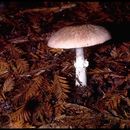pms
nòm ant ël fil


Guidance for identification
Agaricus benesii[1] is an agaric mushroom of the genus Agaricus. This mushroom can be distinguished by a white cap that bruises pinkish-red when injured, a scaly lower stipe, and a conifer habitat. Similar to Agaricus californicus and A. xanthodermus, the cap discolors brown in age. A distinguishing feature of A. californicus and A. xanthodermus, however, is a thickened annulus at the margin, a phenolic odor, and a yellowing bruise, instead of red.[2] In the case of Agaricus xanthodermus, it occurs quickly, though faintly to not at all in the case of A. californicus. Another similar species, Agaricus bernardii, also stains red and has white flesh, but differentiates on its larger bulk, a sheathing veil, briny odor, and different habitat, namely grass.[2]
The cap is 4–8 cm (1.6–3.1 in) broad; it has a convex shape which, in age, becomes flat. The flesh is white, moderately thick, and firm. The odor is pungent, even though the mushroom has a mild taste. When injured, it turns a pinkish-red. The surface is white, dry, and innately fibrillose. At the margin, it is finely scaled, though it discolors into a brownish shade in age.[3]
The stem is 5–11 cm (2.0–4.3 in) tall and 1–2 cm (0.4–0.8 in) thick. The stem extends to the enlarged base. At maturity, the stem is stuffed. The surface is white, and turns smooth at the apex, while it is finely scaled below. The partial veil is white, membranous, and two layered. The upper surface is striate, while the lower surface is composed of scaly patches, forming a small, superior annulus. The flesh is white, though it stains red quickly when injured.[4]
The gills are initially unattached to the stem, packed close together, and are pinkish-brown; in age they become blackish-brown.[5] Spores are 5–6 by 3–4 µm, smooth, and elliptical. The spore print is a blackish-brown color.[6]
Found under Monterey Cypress and pines, Agaricus benesii are often in small groups or by themselves. In addition, they fruit from mid to late winter.[7]
Agaricus benesii is an agaric mushroom of the genus Agaricus. This mushroom can be distinguished by a white cap that bruises pinkish-red when injured, a scaly lower stipe, and a conifer habitat. Similar to Agaricus californicus and A. xanthodermus, the cap discolors brown in age. A distinguishing feature of A. californicus and A. xanthodermus, however, is a thickened annulus at the margin, a phenolic odor, and a yellowing bruise, instead of red. In the case of Agaricus xanthodermus, it occurs quickly, though faintly to not at all in the case of A. californicus. Another similar species, Agaricus bernardii, also stains red and has white flesh, but differentiates on its larger bulk, a sheathing veil, briny odor, and different habitat, namely grass.
Hakaherkkusieni (Agaricus benesii) on herkkusieniin kuuluva sienilaji.
Laji on Suomessa harvinainen ja se on tavattu vain pari kertaa. Lajin elinympäristöä ovat hakamaat, metsittyvät niityt ja kompostit. Hakaherkkusieni menestyy parhaiten kalkkipitoisilla mailla[1]. Sieni on nuorena väriltään valkea. Lakin pinta on hienosuomuinen ja jalan rengas erottuu selvästi. Kun sientä painaa muuttaa kosketuskohta väriään punaiseksi. Lähes kaikki muut valkeat herkkusienet ovat kellertyviä. Hakaherkkusienen tuoksu on heikko, ei selkeän anismainen. Hakaherkkusieni on syötävä, mutta harvinaisuutensa vuoksi lajin merkitys ruokasienenä on vähäinen.
Hakaherkkusieni (Agaricus benesii) on herkkusieniin kuuluva sienilaji.
Laji on Suomessa harvinainen ja se on tavattu vain pari kertaa. Lajin elinympäristöä ovat hakamaat, metsittyvät niityt ja kompostit. Hakaherkkusieni menestyy parhaiten kalkkipitoisilla mailla. Sieni on nuorena väriltään valkea. Lakin pinta on hienosuomuinen ja jalan rengas erottuu selvästi. Kun sientä painaa muuttaa kosketuskohta väriään punaiseksi. Lähes kaikki muut valkeat herkkusienet ovat kellertyviä. Hakaherkkusienen tuoksu on heikko, ei selkeän anismainen. Hakaherkkusieni on syötävä, mutta harvinaisuutensa vuoksi lajin merkitys ruokasienenä on vähäinen.
Vit blodchampinjon (Agaricus benesii) je grzib[8], co go nojprzōd ôpisoł Albert Pilát, a terŏźnõ nazwã doł mu Albert Pilát 1951. Vit blodchampinjon nŏleży do zorty 'Agaricus' i familije Agaricaceae.[9][10][11]
Vit blodchampinjon (Agaricus benesii) je grzib, co go nojprzōd ôpisoł Albert Pilát, a terŏźnõ nazwã doł mu Albert Pilát 1951. Vit blodchampinjon nŏleży do zorty 'Agaricus' i familije Agaricaceae.
У молодих грибів шапка білувата, у зрілих — жовтувато–коричнева, товста, м'ясиста, поверхня дрібнолуската. Діаметр шапки до 13 см, у молодих грибів вона напівкругла, у дорослих — випукло–розпростерта, з досить широким тупим горбиком. Ніжка завдовжки до 13 см, завширшки до 2,5 см, біла, над кільцем ніби гола і до того ж рожева, нижче кільця білувата, вкрита оригінальними лусками. Якщо луски підсихають у суху погоду, то майже непомітні. Кільце на ніжці дещо потовщується на краю.
Гриб зустрічається на ґрунті, на галявинах, у парках, у хвойних та листяних лісах.
Печериця дрібнолуската — добре відомий їстівний шапковий гриб, який грибники вживають у їжу зазвичай у свіжому вигляді.